- Submissions

Full Text
Environmental Analysis & Ecology Studies
Evaluation of the Relationship between the Use and Occupation of the Soil and the Quality of Water from an Experimental Basin through the Water Quality Index (Iqa) and Tropical State Index (Eit)
Vania Elisabete S1*, Renata Cornelli2, Naubert Zanoni3, Sofia Helena Zanella Carra4, Gisele Cemin5 and Geise Macedo dos Santos6
1PhD in Water Resources Engineering and Environmental Sanitation, Hydraulic Research Institute, Brazil
2Master and PhD in Production Engineering, Brazil
3MSc in Engineering and Environmental Sciences, Brazil
4Master in Engineering and Environmental Sciences, Brazil
5Graduated in Biological Sciences from UNIVATES, PhD in Remote Sensing at UFRGS, Brazil
6Civil Engineering Student, Scientific Initiation Scholarship (BIC/UCS), Brazil
*Corresponding author: Vania Elisabete Schneider, PhD in Water Resources Engineering and Environmental Sanitation, Hydraulic Research Institute, Brazil.
Submission: June 06, 2018; Published: December 04, 2018

ISSN 2578-0336 Volume4 Issue5
Abstract
This study aimed to verify the influence of land use and occupation on the quality of water resources in an experimental watershed, in order to assess the impact of pig activity through the Water Quality Index (WQI) and Trophic State Index (TSI). To do so, they were prepared using maps and land occupation with the aid of satellite images in which were defined using 6 classes (native forest, agriculture, forestry, exposed soil, water depth and clouds/shadows) and, in parallel, there were 14 monitoring campaigns of water quality in the period August 2012 to February 2015 at 7 sampling points. With the analysis of the results it was observed that in 88% of the samples ranged from WQI fair and poor, very close to the lower limit, by virtue of the presence of coliform, turbidity, total phosphorus, total nitrogen and total solids. For the TSI, there was a significant presence of phosphorus and chlorophyll-a leading in 91% of the samples, the trophic level between hypertrophic and super trophic.
The values that WQI and TSI may be associated with installed pig activity in the region, due to the significant generation of waste and the resulting environmental impacts added to the mismanagement of this, beyond sanitary wastewater generated by the municipalities that make up the experimental basin, whose release into waterways without an effective treatment corroborates reducing quality.
keywordsWQI; TSI; Use and land use; Water quality; Water resources
Introduction
The classification of water bodies into classes, according to the prevailing uses, is provided for in CONAMA Resolution No. 357/05 (Brazil, 2005) and is one of the instruments used to assure water quality compatible with the most demanding uses. intended. These uses can be influenced according to the use and occupation of the soil found in the river basin. It is understood by use and occupation, the characterization of a set of collective activities in an urban grouping. It can be said that it is the reflection of the social advance in the civilized space, being that it can occur use of the ground without being essentially occupied, although the occupation represents one of the types of use. Therefore, the analysis on the theme is extremely important, justifying the need to identify the environmental change systems resulting from anthropic actions De Oliveira Santos et al. [1].
Anthropogenic actions generate significant changes in the landscape due to the replacement of areas with natural forest cover by other types of cover. Many factors are intrinsic to this process, influencing natural resources, as well as affecting biodiversity Coelho et al. [2]. According to Schneider et al. [3], a natural hydrological cycle is formed by distinct physical, chemical and biological principles and, human intervention on this system, brings the direct impacts to the human being or to nature. Also, according to Schneider et al. [3], in areas used for agriculture, superficial modifications are necessary to allow the introduction of other crops. In general, the change of cover changes the roughness, thus affecting the runoff during rains. With increasing roughness through plants or terraces, the reduction in the amount of charges forming the surface occurs which can somehow be drawn into the aquatic environment.
In this context it is possible to mention the application of swine manure as organic fertilizers in agriculture, this being a very common practice in properties where livestock activity is associated with agricultural activity. However, during the rainfall events, fertilizer from pig manure has a high concentration of elements considered important for plant growth, such as phosphorus, nitrogen, potassium and also organic matter Merten & Minella [4]. of the nutrient load causing negative impacts on soil, water resources and the well-being of the population Konzen [5]. In order to verify if the way the soil is being used causes impacts to the water resources, it is necessary to establish ways of assessing the degradation of surface waters that are easy to interpret or to constitute a monitoring system for the use of simple methodologies that result in clear and objective information, using criteria that consider the characteristics of each water resource in order to allow the monitoring by means of synthesized information of the possible wear of the water resource either in a specific way, along the basin or over time Toledo & Nicolella [6].
In order to facilitate the understanding of the results and qualitative analyzes related to water quality, including for the non-technical public, the National Water Agency (ANA) has been stimulating the use of indices that use multiparameter statistical techniques to standardize data collection and analyzes. Water. In this way, the application of the Water Quality Index (IQA) and the Trophic State Index (EIT) become valuable tools in obtaining didactic results to measure water quality. In this context, the objective of this study was to relate soil use and occupation to water quality through the application of the Water Quality Index (IQA) and the Trophic State Index (EIT) in an experimental river basin with intense agricultural activity.
Swine breeding in the state of Rio Grande Do Sul
Among the Brazilian states, Rio Grande do Sul is the second largest producer of pigs, surpassed only by the state of Santa Catarina. In the state of Rio Grande do Sul, the swine chain has a high socioeconomic importance due to the state’s participation in exports, facilitating regional integration and increasing the value added to pork as a final product [7]. Still according to the pig herd is present in practically all regions, although more concentrated in the north and northeast, integrated the proximity of the processing industries. Hookah et al. (2006) reported a high pollutant potential for the generation of large amounts of liquid effluents, rich in nutrients, BOD, pathogens, sediments and heavy metals.
According to Lazaretti et al. [8], in comparative terms, the pollutant potential generated by the one-animal waste is equivalent to the pollutant potential generated by four humans. According to Leite et al. [9], with the growth of swine, there is an increase in the generation and release of waste in small areas, causing environmental degradation and consequent loss of quality of life. In this way, when waste is disposed of without proper management, it can have a major environmental impact.
Materials and Methods
This section will present the area of study, information on monitoring campaigns and land use and occupation, as well as the methodologies for calculating the IQA and the EIT. The experimental basin used to perform this work is composed by four municipalities: Serafina Correa, Montauri, União da Serra and Guaporé, located in the hydrological site of the Guaporé River, in the region of the middle Taquari-Antas, in the northeast of the state of Rio Grande do South. It was defined based on the characteristics of land use and coverage, pedology, hydrography, hypsometry, clinography, location points and installed capacity of animals, plotted on a single basis.
Between August 2012 and February 2015, 14 qualitative and quantitative campaigns were carried out to monitor water resources through the project “Sanitation in the rural environmentevaluation of swine activities and impacts on water quality in the region covered by Corede (Figure 1) presents the experimental basin in relation to the municipalities, the location of the swine farmers and the monitoring points of the quality of the water resources.
Figure 1:Experimental watershed and sampling points.
Source: Isam (2013)-prepared by Gisele Cemin.
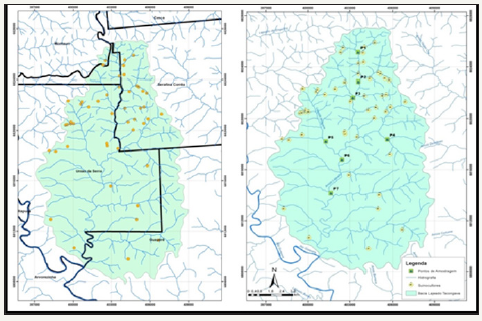
Monitoring campaigns
To monitor the quality of water resources, seven sampling points were defined in which 14 monitoring campaigns were conducted on a bimonthly basis between August 2012 and February 2015. In each campaign, Physico-chemical and biological parameters were determined, dissolved oxygen, pH, conductivity, total dissolved solids, turbidity, oxidation-reduction potential, water temperature, air temperature, chemical oxygen demand, biochemical oxygen demand, ammoniacal nitrogen, nitrogen kjedahl, nitrate, phosphorus total potassium, total solids, total suspended solids, thermotolerant coliforms, Escherichia coli, chlorophyll a, zinc, copper and macro invertebrates.
The parameters dissolved oxygen, pH, conductivity, turbidity, oxide-reduction potential, water temperature and air temperature were determined in the field using a HORIBA® model U-50 SERIES multiparameter probe. The quantification of nitrate followed the Norm ABNT NBR 12620-1992. The other parameters were determined according to the procedures presented in the Standard Methods for the Examination of Water and Wastewater [10].
Soil use and occupation
The land use and occupation map of the experimental basin was elaborated from a TM/Landsat 5 satellite image for the year 2011, through the visual interpretation of the shape, texture, hue/color and spectral behavior of the units which composes the landscape. Six classes of soil use and cover were listed: native forest, silviculture, agriculture, exposed soil, water depths and clouds/shadows. The delimitation of the perimeter of the basin was performed using data referring to relief (contour lines) and water grid, information available in the digital cartographic base of Rio Grande do Sul, in the 1: 50,000 scale. For the manipulation of this information and also for the data processing, Idrisi software was used and for layout ArcMap 10.
IQA e IET
The Water Quality Index (IQA), proposed by Cetesb and adapted from the National Sanitation Foundation (NSF) and the Trophic State Index (IET), from Lamparelli [11], were applied from the results of the qualitative monitoring of water resources. 2004). According to [12], the calculation of the index is composed of 9 variables considered relevant for the evaluation of water quality based on the opinion of experts in this area. Table 1 shows the quality parameters and respective weights. Table 2 shows the classification of water quality according to the IQA.
Table 1:Parameters of water quality and their weight.

Table 2:Classification of water quality according to IQA.
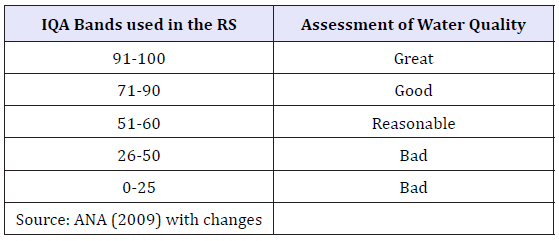
The results of the ETI corresponding to phosphorus, EIT (Pt) should be understood as a measure of eutrophication potential, since this nutrient acts as the causative agent of the process. The evaluation corresponding to chlorophyll a, IET (Cl-a), in turn, should be considered as a measure of the response of the water body to the causative agent, indicating in an adequate way the level of algae growth in the aquatic body. Due to the possibility of different classifications for the analysis of the two parameters, the average EIT, which is determined by the arithmetic mean between the EIT (Pt) and EIT (Cl-a) results, should be calculated. In the case of basins with high organic matter, nutrients and other pollutants, the determination of the EIT allows a consistent assessment of the degradation state of the water body.
Results and Discussion
Soil use and occupation
After analysis of Figure 2, it is possible to affirm that most of the area under study (45.17% of the total), in which the points 5, 6 and 7 are located, is covered by native forest, called the Mixed Ombrophylous Forest -Araucária Forest (FOM) and close to water resources, where it is characterized by different stages of ecological succession. The silviculture areas represent 1.18% of the area of the basin, being especially inserted in the areas of fragments of native forest.
Figure 2:Map of use and coverage of just.
Source: Isam (2013) elaborated by Gisele Cemin and Geise Macedo Dos Santos.
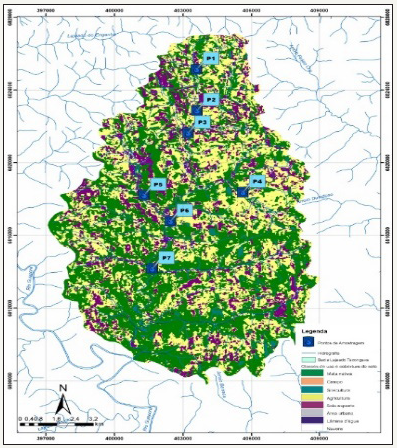
As for the regions with agricultural activity, they occupy 37.20% of the area, being more expressive in the northeast region (in which the points 1, 2, 3 and 4 are located). The area with exposed soil (mostly cultivated areas not currently used or still prepared for planting) amounts to approximately 16% of the area of the experimental basin. Water slides occupy only 0.75% of the region. The clouds, described in the table, cover 0.03% of the study area, and were detected when the satellite image was captured
Monitoring campaigns
Table 3 presents the mean results of each parameter for each sampling point over the 14 monitoring campaigns used in the IQA and EIT calculations. The results showed that the highest values are presented in points 2, 3 and 5 when compared to the other points for the parameters of thermotolerant coliforms, BOD, total phosphorus, total nitrogen kjeldahl, solids and turbidity. The lowest concentrations of these parameters were observed in points 4 and 7.
Table 3:Class of trophic state and its main characteristics.
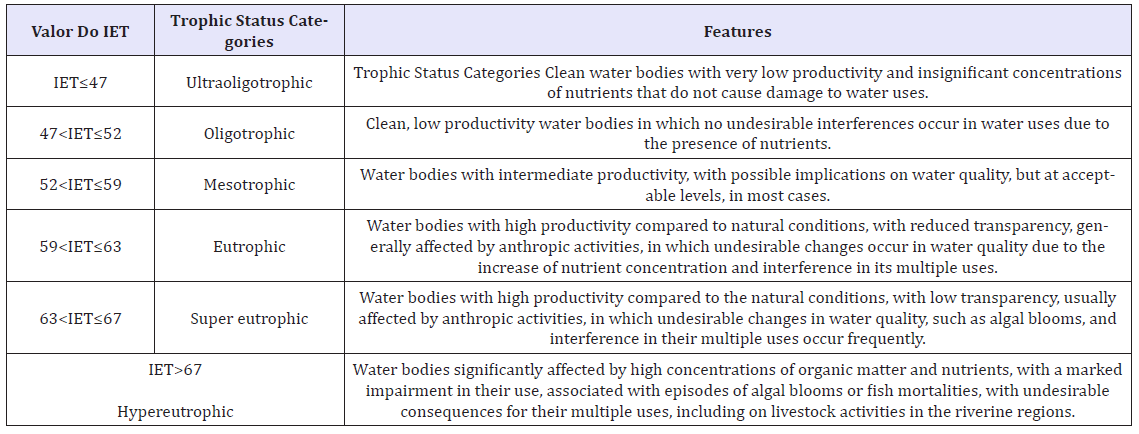
Source: Lamparelli [11] & Cetesb [14].
Water quality index
Figure 3:IQA score.
Prepared by the authors (2015).

Table 4:Presents the data referring to the occupation of the River Basin area with the different classes of use.

Figure 3 shows the IQA result for the experimental basin. It is observed that in the 4th campaign the worst indexes were obtainedthis fact is related to the increase in the presence of Escherichia coli, turbidity and variations in the concentration of total phosphorus, Kjeldahl nitrogen and total solids-where only points 1 and 4 resulted in quality, however, very close to the lower limit. In the other campaigns, only points 5, 3 and 2 of the respective 9th, 12th and 14th campaigns resulted in IQA classified as poor. Note that in the same monitoring campaign, there is a positive change in the IQA between the points, that is, the index of a downstream point presents better quality when compared to the upstream point. This phenomenon can be a consequence of the auto depuration of the water resources, potentiated by the topography of the region and by the flow. When comparing the monitoring points, point 5 presents the worst results, due to the variation in the concentration of thermotolerant coliforms and turbidity during the campaigns carried out (Table 4).
Trophic status index
Figure 4:Results of degree of trophy.
Prepared by the authors (2015).
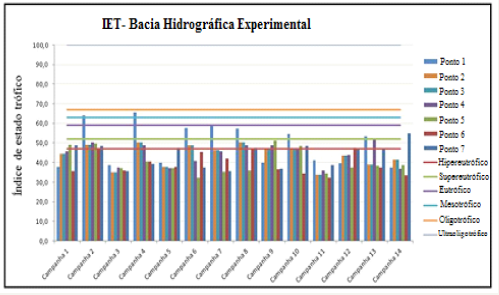
The total phosphorus concentration at the sampling points ranges from 0.01 to 0.435mg/L. For this parameter, 23% of the samples were classified as class 4, 52% as class 3 and 25% water as class 2, according to CONAMA Resolution 357/2005 [13]. For chlorophyll-a, the variation obtained was between 0.05 and 16.02mg/m3, when only this component was observed, 7.1% of the samples as class 2 and 92.9% as class 1, according to same resolution. Figure 4 shows the trophic degree at the monitored collection points.
When comparing the results shown in Figure 4, it was observed that in 8 of the 14 collections, point 1 presented the worst results. For campaign 4, the results were driven by the high quantities of both components determined for the calculation of the EIT. For the other campaigns, there is a variation between factors. In approximately 91% of the analyzes the results varied between hypereutrophic and super eutrophic, which shows that these bodies of water receive high contributions of organic matter and nutrients, compromising their uses and, associated with algal blooms and/or fish mortalities, leads to undesirable consequences for its multiple uses, including on pig farms in the regions [14].
Final Considerations
Based on the evaluation of the use and occupation of the soil (Table 5) in the experimental river basin and the results of the Water Quality Index (IQA), in which 88% of the samples remained between regular and bad and the Trophic State (EIT), where 91% of the samples presented in the hypereutrophic and super eutrophic range, it is possible to conclude that:
Table 5:Mean results of each parameter at each point.

Prepared by the authors (2015).
A. The application of swine manure as an organic fertilizer without the proper management of it may be influencing the quality of water resources as well as the degree of trophia. This fact may be related to the application of these fertilizers in agricultural crops during rainy periods and/or in high concentrations that exceed the absorption capacity of the soil and the plants, resulting in the leaching of nutrients to the receiving water body.
B. The lack of efficient treatment of sanitary effluents in municipalities can also contribute to the high concentration of organic matter and nutrients in water resources.
C. Removal of riparian forest or vegetation near rivers is another factor that can contribute significantly to the reduction of the quality of water resources.
D. For point one, the high trophic level may be related to the high concentration of swine farmers in the vicinity of this collection point and, for the downstream points, the improvement in the EIT may be related to the auto depuration.
This work allowed to evaluate the quality of the water resources that compose the experimental river basin, whose results demonstrate the need for a greater control over the disposition of animal waste in agricultural soil, as well as the need to encourage the implementation of more efficient forms of treatment of these before being used as organic fertilizers. The incentive of the recovery of the permanent preservation areas in the water resources and the treatment of the sanitary effluent coming from the municipalities that compose the experimental river basin are also necessary with a view to the improvement in the surface water quality in the study area [15].
References
- De Oliveira Santos LTS, De Jesus TB, Nolasco MC (2014) Influence of soil use and occupation on the surface water quality of the Subaé River, Bahia. Geographia Opportuno Tempore 1: 68-79.
- Coelho VH (2014) Dynamics of soil use and occupation in a basin of the Brazilian semi-arid region. R Bras Eng Agríc Environmental 18(1): 64- 72.
- Schneider RM (2011) Study of the influence of soil use and occupation on the water quality of two streams in the Pirapó-doi river basin. Acta Scientiarum: Technology 33(3): 295-303.
- Merten GH, Minella JP (2002) Water quality in rural watersheds: a current challenge for future survival. Agroecology and Sustainable Rural Development 3(4): 33-38.
- Konzen EA (2005) Deferment of fermented pigs in biodigesters and their environmental impact as an agricultural input. Embrapa Maize and Sorghum-Article in (ALICE), Goiânia: AVESUI Center-West. In: Goiano Symposium of Avicultura, annals of congress, The symposium goiano of suinocultura, p. 2.
- Toledo LGD, Nicolella G (2002) Index of water quality in microbasin under agricultural and urban use. Scientia Agricola 59: 181-186.
- SEPLAG (Secretariat of Planning, Management and Citizen Participation) (2013) Socioeconomic atlas rio grande do sul pigs, Porto Alegre, Brazil.
- Lazaretti RMJ, Santos JMGD, Andreazzi MA (2013) ssAllocation of swine residues to farms in the Southwest, North and Northwest regions of the State of Paraná. VII EPCC-International Meeting of Scientific Production. Maringá: UNICESUMAR-Centro Universitário Cesumar, Brazil.
- Leite RA (2014) Evaluation of the continuous tubular flow biodigestor model vinebiodigestor, through chemical analysis during the treatment of pigs. UNOPAR Científica Exact and Technological Sciences 10(1): 2317-4013.
- APHA (American Public Health Association) (2012) Standard Methods for Examination of Water and Wastewater. (22nd edn), Washington, USA.
- Lamparelli MC (2004) Degree of trophy in water bodies in the state of São Paulo: Evaluation of monitoring methods Thesis (Doctorate). University of São Paulo, São Paulo, Brazil.
- CETESB (2015) Environmental Company of the State of São Paulo, IQAWater Quality Index. Sao Paulo, Brazil.
- (2005) Resolution 357 of March 17, Brazil.
- CETESB (2014) Environmental Company of the State of São Paulo, IET - Index of Trophic Status. Sao Paulo, Brazil.
- Higarashi MM (2006) Recommendations for management of superimposed bed system in the growth and termination phases.
© 2018 Vania Elisabete Schneider. This is an open access article distributed under the terms of the Creative Commons Attribution License , which permits unrestricted use, distribution, and build upon your work non-commercially.
 a Creative Commons Attribution 4.0 International License. Based on a work at www.crimsonpublishers.com.
Best viewed in
a Creative Commons Attribution 4.0 International License. Based on a work at www.crimsonpublishers.com.
Best viewed in 







.jpg)






























 Editorial Board Registrations
Editorial Board Registrations Submit your Article
Submit your Article Refer a Friend
Refer a Friend Advertise With Us
Advertise With Us
.jpg)






.jpg)














.bmp)
.jpg)
.png)
.jpg)










.jpg)






.png)

.png)



.png)






